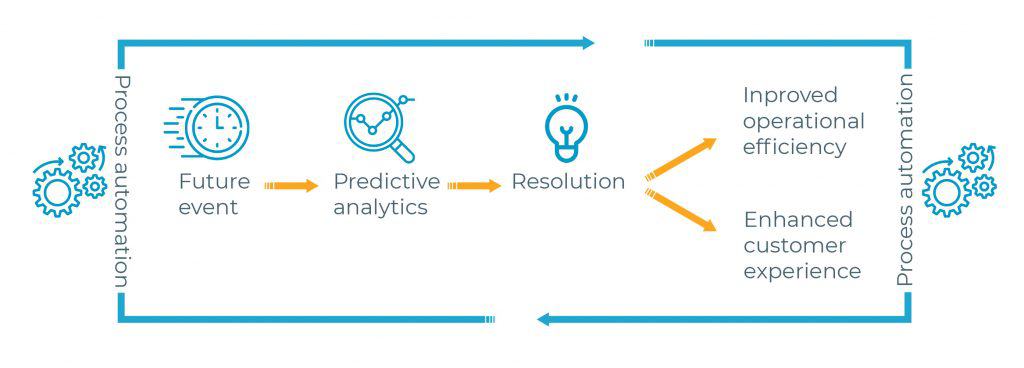Introduction: 5G Challenging New Reality
As operators roll out their 5G networks, including the first Standalone deployments, smartly monitoring and optimizing them has become substantially challenging. The introduction of new core technologies alongside legacy networks, and the significant increase in data traffic generated through millions of additional connected devices, have made networks increasingly complex, reaching the point where they can no longer be reliably monitored by humans alone.
It is apparent that for 5G, the traditional network operations and management model will not meet the increasing requirements needed. The 5G network emphasizes a more personalized customer experience and guarantees a certain quality of service and SLAs, which calls for an evolved network and proactive approach to monitoring. An intelligent, more automated network utilizes Artificial Intelligence (AI) and Machine Learning (ML) to transform its internal processes which can also be embedded into the 5G core as the NWDAF function for a closed-loop approach to network operations. How can operators support 5G innovative nature and capabilities with predictive assurance?
This newly adapted network will better analyze large datasets, identify complex data patterns and, thereby, make accurate predictions. To do so, this network must rely on advanced automated assurance solutions or the NWDAF that employ equal levels of innovation at their core functionality. Since, in the end, the success of 5G depends on whether operators can manage these networks more efficiently while ensuring a superior customer experience.
The Advantages of Combining Assurance with Predictive Analytics
Automated assurance that is coupled with NWDAF, is the cornerstone for operators to manage their networks more efficiently and deal with the increasing complexity. It also supports the development of innovative use cases, like network slicing and edge computing, and help operators be proactive in managing their 5G network.
While, in the past, assurance activities and network operations have been primarily manual, time-consuming, and reactive. When enhanced by AI and ML, today’s automated assurance and the NWDAF function are the key to unlocking the ability to offer quality, dynamic services at scale by delivering automated insights about network maintenance and operational processes. Thus, enabling operators to dynamically manage in real-time the customer experience policies across the network.
Implementing AI/ML-driven predictive operations is a capability that allows operators to go beyond routine network monitoring by using the data history to create actionable insights into the future of the network’s operations and predict when fluctuations in traffic will occur and know when more network resources will be needed.
Reaching that critical goal will empower operators to apply sophisticated analytical ML modules and algorithms to more extensive and diverse datasets, increasing analytical predictions’ extent, speed, and accuracy.
The detected data patterns will help improve and optimize network and service performance by detecting hidden network anomalies in near real-time. As an operator, utilizing advanced ML-based modules for root cause analysis will introduce a leap forward from existing rule-based techniques; While other modules, such as dynamic thresholds, will enable you to deploy new preventive measures to improve operational efficiencies.
Apply a Full Predictive Assurance Insights Toolset
Predictive capabilities
Predictive assurance coupled with NWDAF serves as the foundation for automating networks’ operational processes, delivering end-to-end network troubleshooting, and complete service and customer experience visibility.
As an operator, by applying AI/ML algorithms on large datasets from multiple sources you will be able to reveal deep, actionable insights about the network’s services and performance behavior, auto-detecting anomalies, and indicating future degradations.
When combined with telecom domain expertise, these advanced ML modules can continuously auto-learn the network’s behavior, absorbing each unique dataset combination and its separate timeline in a scalable way. Thus, predicting network issues, pinpointing the root cause, and then starting with remediation actions.
By acting upon these automated insights, you can automate your 5G network’s performance and maintenance processes, achieving higher efficiency levels and providing quality services to your subscribers. As more advanced 5G services roll out the NWDAF functionality can be used to manage the network in real-time and enable operators to transition to closed-loop operations.

Applying AI/ML Predictive Assurance
Predictive Assurance Use Cases
AI/ML-driven predictive assurance can analyze data sessions in real-time to support the following use cases:
- Analyze payload anomalies (cell, site, area, NE) – Predict network performance future changes by analyzing the traffic changes on a cell or area level. In some cases, there is a delay between the time of traffic change to other performance indicators’ noticeable changes. Hence, we can consider traffic changes as predicting other KPIs’ potential anomalies.
- Dynamic thresholds – Definition of threshold models to analyze evolving network patterns to proactively detect problems and, thus, create new threshold-crossing alarms. The thresholds are later fine-tuned to better detect non-trivial network problems at an early stage.
- Evaluate relations between different alerts (types, names, time series, etc.)- In some situations, specific time series might present anomalous behavior that would indicate another time series will trigger an alert in the future. By identifying alert precedence relations, using historical alert correlations, we can forecast an alert that is activated.
- Alert density changes – Evaluate the increase of important alarms based on a cumulative number of historical alerts. Analyzing the alerts density over time, with seasonal effects, enables forecasting an unexpected change in the number of anomalies triggered.
Predictive Assurance and Closed-Loop
A closed-loop, AI/ML-driven, predictive assurance process will enable you to provide better services to your customers by:
- Introducing ML algorithms to develop continuous auto-learning capabilities.
- Analyzing large datasets to identify complex patterns.
- Automatically detecting network performance issues and predicting future network failures by scheduling regular data forecasts and trend analysis.
- Forecasting services degradations and SLA violations.
- When an alarm is triggered, automatic opening of a trouble ticket.
- Correlating cross-domain network alarms, analyzing faults impact, and automatically identifying the root cause.
- Based on all the insights gained, faults are automatically corrected, and issues are resolved before subscribers are affected.
As a result, complex network processes are automated to support self-healing and closed-loop orchestration. This will save significant resources, improve the overall customers’ experience and reduce expensive downtime.
For example, operators can predict, with a very high level of certainty, that a specific device or cell site, router, or any kind of network entity will fail within the next X hours/days. In such a case, operators would like to try to avoid a failure, or maybe they would like to try to make sure they have enough backup resources to mitigate the failure, hence, minimizing the customer’s impact. Instead of responding to problems that arise, with predictive assurance, you can use the data to perform predictive maintenance on the network, allowing you to stay ahead of potential failures and issues.
Summary
In conclusion, as 5G rollouts continue to gain momentum, operators will be challenged to support its innovative nature and capabilities while delivering new service offerings enabled by advanced technologies, such as slicing and edge computing. In order to overcome the challenges, operators will need to utilize predictive assurance or NWDAF to offer automated insights that would lead to improved network maintenance and operational efficiency.
RADCOM ACE is our automated, predictive assurance and enhanced NWDAF solution that seamlessly integrates into the 5G core as a Cloud-Native Function (CNF) and provides real-time subscriber analytics and E2E troubleshooting capabilities. Leveraging built-in AI/ML capabilities provides operators with the unique ability to analyze large datasets, identify complex data patterns, and, thereby, make accurate predictions to auto-improve the network’s performance.
Being dynamic and fully integrated enables operators to take an on-demand, closed-loop approach to assure a superior customer experience by delivering actionable insights into the future of their 5G networks’ operations.
This blog was published as part of Light Reading’s Partner Perspective series.
To learn how to assure the lifecycle of your 5G network download our infographic.
This article is subject to RADCOM’s disclaimers regarding Forward-looking statements and general information under the links below:

